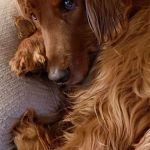
Goldendoodles, the cross between the Golden Retriever and the Standard Poodle, come in a variety of generation numbers. When buying or searching for Goldendoodles, you will come across stuff like the F1, F1B, F2, F3, and F1BB.
The first generation or the F1 pups are the most common types, since they are 50 percent Golden Retriever and 50 percent Poodle. But how about the F1BB? Not all Goldendoodle breeders develop these dogs. Get to know more about them in today’s post.
CHECK LATEST PRICE OF DOG CAMERA
Amazon.com
F1BB Goldendoodle Lineage
These Doodle dogs are also called the backcross Goldendoodle. This is the result of pairing a Poodle with an F1B Goldendoodle.
It is among of the so-called multi-generation Goldendoodles. Multi-gen pups are those belonging beyond the second generation.
An F1B Goldendoodle is 75-percent Poodle and only 25-percent Golden Retrieverbecause an F1B Goldendoodle is the combination of first generation Goldendoodle and a Golden Retriever.
With more of the Poodle’s gene in its pedigree, you can expect the F1BB Goldendoodle to get the majority of the traits and features of Standard Poodles.
F1BB Goldendoodle Traits
The F1BB Goldendoodle takes over more of the characteristics of Poodles, who have many wonderful characteristics. They are intelligent, loyal, and fun-loving.
Standard Poodles boast a long lifespan, living up to 12 to 15 years on average. Poodles will live a long and happy life given they are taken care of accordingly.
Part of caring for Poodles is making sure they are fed a diet according to their age, weight, and lifestyle. They need a moderate amount of exercise per day.
Like the Poodles, F1BB Goldendoodles may have hip dysplasia, progressive retinal atrophy, epilepsy, bloat, and thyroid issues. While most of the health issues related to Goldendoodles can be prevented through a healthy lifestyle, some of them are hereditary.
This is why it’s important to get your pooch from a reliable breeder. Puppy mills will not screen dogs for genetic problems, so you will not be able to see their paperwork.
Ask about the Goldendoodle’s parentage, like information regarding their pedigree and DNA. Don’t just rely on breeders that can provide an AKC certification because it cannot assure a pup’s state of health.
This Doodle dog could be a good hunter, just like the Poodle parent. Poodles have a reputation for being effective hunters, since they were originally bred to retrieve fallen birds for hunters in Germany.
Does An F1BB Goldendoodle Shed?
The F1BB is the least shedding generation of Goldendoodles. This Doodle dog is recommended for people who often suffer from pet allergies but still want to have a dog.
It resembles the Poodle’s corded or loose curls which start appearing at the age of nine months. As pups, Poodles will display a wavy and soft coat texture but this will change over time.
Standard Poodles go through a coat changefrom nine to 16 months of age. During this stage, it helps to brush the coat regularly with a pin brush to avoid tangles.
You can see them in a variety of colors, ranging from cream, red, and brown to black and apricot. Standard Poodles are among the breeds with many acceptedcoat colors.
Like Poodles, they are minimal shedders and because of this, they are also regarded as being hypoallergenic. There is no such thing as a hypoallergenic pet, but some dogs don’t cause as many allergy symptoms to humans compared to other breeds.
The reason why Poodles don’t shed is that any fallen hair gets trapped in their curls. Those curls, however, are quite difficult to groom. These dogs need high levels of maintenance and grooming should be done regularly.
In case your F1BB Goldendoodle sheds in a strange amount, look for signs of skin problems like inflammation and itching. Other possible causes of excessive shedding in Poodles are red mange, allergies, and hypothyroidism.
Some Poodles also inherit an inflammatory skin problem called Sebaceous Adenitis. Common in young and middle-aged Poodles, this disease results in thinning of the hair that leads to hair loss.
F1BB Goldendoodle Grooming
These Goldendoodles got the curls of the Poodles meaning they also need intensive grooming to maintain the health and beauty of their coat. Otherwise, they may develop skin problems like dryness and itching.
Poodles have a single and dense coat, which means you need to invest in a durable brush for them. A big slicker brush is ideal for medium-sized Goldendoodles. Always look for bristles that are not too hard and not too soft.
If your pooch happened to develop mats, comb its coat using a de-matting brush. This does the job well in addition to instantly cleaning your pet’s coat. Do it gently to avoid hurting your buddy.
Part of grooming them is clipping their coat. This process, also referred to as professional grooming, should be done on adult Goldendoodle every three to six weeks.
Clipping is not just for aesthetic purposes, although it can actually give your fur baby a neater look. Clipping it off actually prevents tangles and mats that can damage the coat.
Bathing Goldendoodles should be done every two to three weeks. It gives their skin a “reset.” Place them in a tub to allow water to saturate well in their coat. Since they have a dense coat, it takes longer than other breeds before their coat becomes completely well.
When bathing your Goldendoodle, fill his tub with lukewarm water. It is recommended to use a mild shampoo or conditioner formulated for dogs, consisting of natural ingredients like aloe and lavender.
Conclusion
F1BB Goldendoodles are the best dogs to have if you want a low-shedding pet. This trait makes them the ideal choice for allergy sufferers. Do note, however, that these dogs require high maintenance because their coat resembles the curly one of the Poodles.























